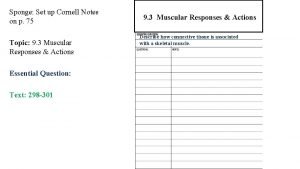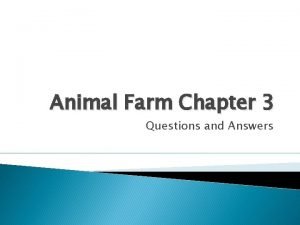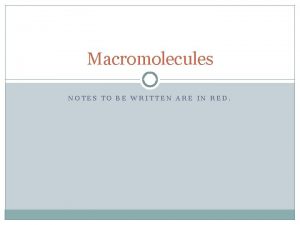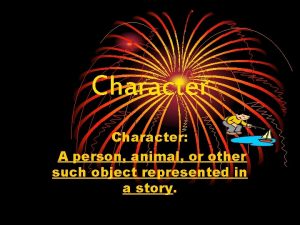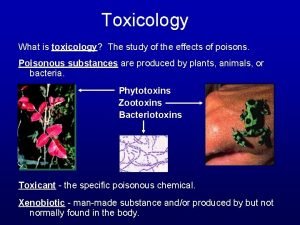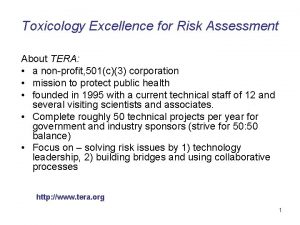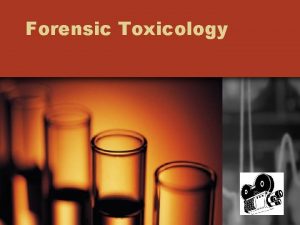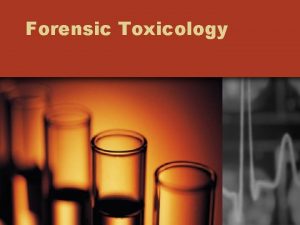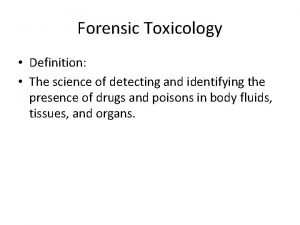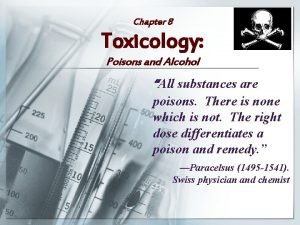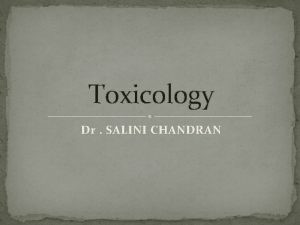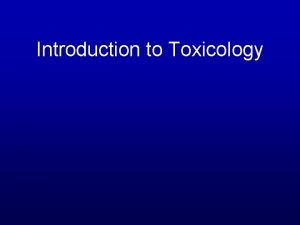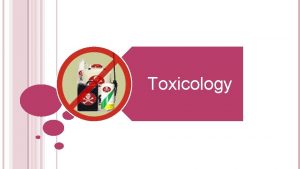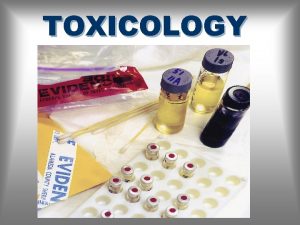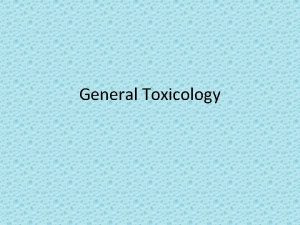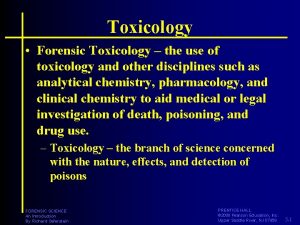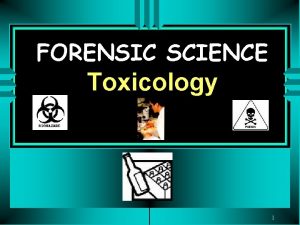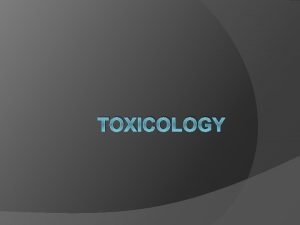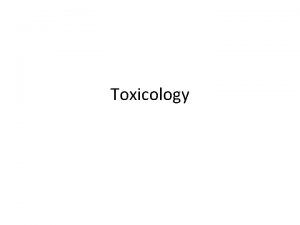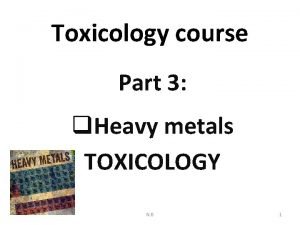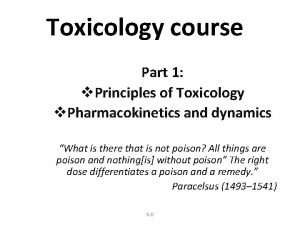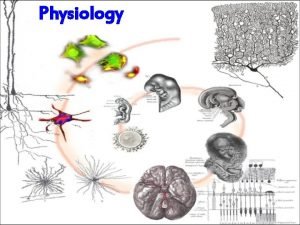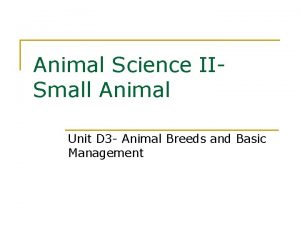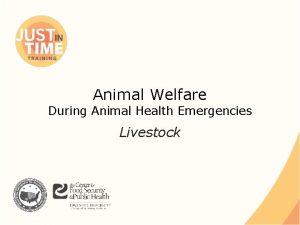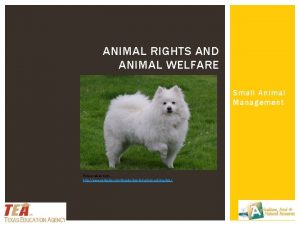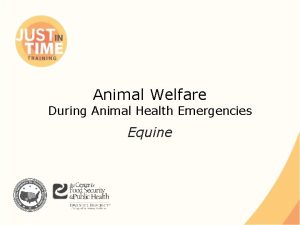Toxicology course Part 8 v Toxicology of animal



























- Slides: 27

Toxicology course • Part 8: v. Toxicology of animal poisoning

Definition • Venom is an animal poison contains different types of antigens as: (proteins enzymatic as protease, phosphodiesterases, hyaluronidases, phospholipase). • Proteins toxics: acids amines, polypeptides. has to be injected into circulation.

Snakes • Snakes are nocturnal reptiles & undergo hybridization, classified into:

Classifications of snakes • According to the dominant venom: • Snake venom: Mixture of specific toxins (peptides& small proteins as hemotoxin, neurotoxin, cardio toxin, …) and spreading factors (enzymes as hyalourindase, phospholipase A, …) 1. Hemotoxic: vipers 2. Neurotoxic : cobra 3. Myotoxic : Sea snakes

• Neurotoxic venom: • Dominant in cobra venom • 50 -75% have low MW so, dialyzable • Act mainly on neuromuscular junctions -> weakness • dangerous when affect respiratory muscles -> respiratory failure. • Hemotoxic venom : • Dominant in viper snake venom • Have high MW so, not dialyzable • Mainly composed of hemolysin, thromboplastin, cardiotoxin • Can cause: hemolysis, destruction of vascular endothelium, cerebral and intestinal hemorrhage, hypotension & shock, and tissue necrosis.

Snake Venom composition • Snake venom consists of proteins, enzymes, substances with a cytotoxic effect, neurotoxins and coagulants. 1. Phosphodiesterases: are used to interfere with the prey's cardiac system, mainly to lower the blood pressure. 2. Phospholipase A 2: causes hemolysis through esterolysis of red cell membranes and promotes muscle necrosis. Snake venom inhibits cholinesterase to make the prey lose muscle control. 3. Hyaluronidase: increases tissue permeability to increase the rate that other enzymes are absorbed into the prey's tissues. 4. Amino acid oxidases and proteases are used for digestion. Amino acid oxidase also triggers some other enzymes and is responsible for the yellow color of the venom of some species. 5. ATPases which are used for breaking down ATP to disrupt the prey's energy fuel use.

Spitting of the venom • is a defensive reaction • The snake tends to aim for the eyes of a perceived threat • a direct hit can cause temporary shock and blindness through severe inflammation of the cornea and conjunctiva. • While there are no serious results if the venom is washed away at once with plenty of water, the blindness caused by a successful spit can become permanent if left untreated. • Contact with the skin is not in itself dangerous, but open wounds may become envenomed.

Clinical Manifestations • The manifestations & severity of the case are depended on: 1. Amount of venom injected 2. Species of snake & nature of venom 3. Site of bite 4. Time of bite 5. Condition of fangs 6. Pathogens in mouth of snake 7. Death may occur immediately due to neurogenic shock


• Neurotoxic Venom: • Start 15 -45 minutes after biting • Local : fang mark (2 punctures), pain, redness, hotness, swelling, & may wet gangrene (generally less prominent than with hemotoxic venom) • Systemic : 1 st sign is ptosis & numbness in lips & tongue – giddiness – heaviness in bitted limb – salivation & vomiting – blurred vision – dysarthria – dysphagia – bradypnea – convulsions – coma & death due to resparatory failure

• Hemotoxic Venom: • Local : prominent and include: fang marks, severe pain, redness, ecchymosis, hotness, edema and swelling of affected limb & dry gangrene • Systemic : nausea, vomiting – hypotension with rapid weak pulse – bleeding from mucous membranes – acute renal failure due to hemoglobinuria – coma and death due to circulatory collapse

Management of toxicity • Reassurance of patient is important • First step is to examine the site of bite and decide if the bite is poisonous or not to avoid unnecessary use of polyantivenom as it is risky and expensive • Immobilize the affected limb • Stop venom absorption as possible using tourniquet proximal to bite (just enough to obstruct lymph drainage not venous drainage) and make 2 small incisions over fang marks, and suction • Don’t use ice fomentations to avoid gangrene or give aspirin to avoid bleeding

• Supportive Treatment: 1. Open IV line and correct fluid, electrolytes and acid-base balances 2. In all cases of snake bite either poisonous or nonpoisonous, we have to give broad spectrum antibiotics and anti-tetanic serum owing to pathogens found in snake mouth

• Specific treatment : • Antivenoms can be classified into: 1. Monovalent (when they are effective against a given species' venom) 2. Polyvalent (when they are effective against a range of species, or several different species at the same time). • Indication: • envenominated bite with systemic manifestations. • Dose : depends on severity of bite not age or body size so a pediatric dose equal an adult dose: - mild give 3 -5 vials - moderate give 5 -10 vials - severe cases give 10 vials & maintain with more vials according to situation

• Antivenoms are purified by several processes but will still contain other serum proteins that can act as antigens. • Some individuals may react to the antivenom with an immediate hypersensitivity reaction ( anaphylaxis ) or a delayed hypersensitivity ( serum sickness ) reaction and antivenom should, therefore, be used with caution. • Despite this caution, antivenom is typically the sole effective treatment for a life-threatening condition • the side effects are manageable, and antivenom should be given as rapidly as the side effects can be managed.

SCORPIONS • Belong to Arthropods • all of them are poisonous & their venoms are more potent than that of snakes & numerically more than snakes, so they represent more public health problem especially in southern areas • Generally, more dangerous & causing more morbidity & mortality in children. Ex: Androctonus amoreuxi

Scorpion Venom • Generally more toxic, more variability of specific toxins & more multiplicity of antigens than snake venom • Consists of amino acids, peptides & small proteins (mainly neurotoxin , nephrotoxin, cardiotoxin, hemolytic toxin, histamine, serotonin, anti-ACh-esterase) & enzymes as phospholipases, hyaluronidases, phosphodiesterase. • Inject able LD: few up to 50 μ g • Human have unique variable susceptibility to scorpion venom

Toxic Mechanism of Scorpion Venom • Neurotoxin: • Block voltage-gated Na+ & Ca++ channels…. prolonged action potential & excessive release of catecholamine…. . adrenergic manifestations • The long-chain polypeptide neurotoxin causes stabilization of voltagedependent sodium channels in the open position, leading to continuous, prolonged, repetitive firing of the somatic, sympathetic, and parasympathetic neurons. This repetitive firing results in autonomic and neuromuscular over-excitation symptoms, and it prevents normal nerve impulse transmissions

• the short polypeptide neurotoxin blocks the potassium channels. • Anti-cholinesterase…. . accumulation of Ach…. . cholinergic manifestations……. this will lead to marked CV effects • Autonomic excitation leads to cardiopulmonary effects observed after some scorpion envenomations. • Somatic and cranial nerve hyperactivity results from neuromuscular overstimulation. • Serotonin may be found in scorpion venom and is thought to contribute to the pain associated with scorpion envenomation. • A smaller child, a lower body weight, and a larger ratio of venom to body weight lead to a more severe reaction


Factors Affecting Severity of Scorpion Sting • Age & body size of the victim • Species & size of scorpion • The amount of venom injected • Site & number of stings • Individual susceptibility to venom

Clinical Manifestations • Local: severe intense pain, edema, numbness & tenderness. • CVS: sinus arrhythmias, hypertension, pulmonary edema, ischemic changes in ECG, complications are more in children with increased LDH & CPK. • CNS : agitation, paresthesia , irritability & (restlessness, severe involuntary shaking &jerking extremity due to somatic skeletal neuromuscular dysfunction). cerebral edema -> convulsions & coma • Others: nausea & vomiting, hypothermia , blurring of vision, tongue fasciculation slurred speech, diaphoresis, tearing

Management of Scorpion Sting • First aid: like snake but, it is mandatory to control local pain (use local anaesthesia) to make the patient calm which is very important procedure in management • Specific treatment: use polyantivenom as in snake • Supportive treatment: - support CV functions to avoid complications - Symptomatic treatment: use Haloperidol to control agitation. use diazepam in convulsions. use diuretics in pulmonary edema

• Don't attempt to cut the wound and suck out the poison. This can cause infection or transfer the venom into the bloodstream of the person attempting to remove the poison. • Scorpions cannot usually deliver enough venom to kill a healthy adult. While venom toxicity varies among species, some scorpions contain very powerful neurotoxins, which, ounce for ounce, are more toxic to humans than the venom of cobras. However, scorpions inject relatively small amounts of venom (compared to snakes), so the overall dose of toxins per sting is survivable.

Black widow spider • Belong to Arthropods • Only female bite is clinically significant • identified by a red to orange hour-glass on the thorax • contains a potent neurotoxin which destroy cholinergic nerve terminals with massive release of A Ch especially at motor end plates causing severe muscle spasm & also, affect adrenergic nerve terminals that may cause increase in sympathetic outflow

Clinical Manifestations • Local: bite usually painless & local reaction is very rare in the form of pain, redness, edema & itching • Systemic: develop 1 -3 hours ranging from mild affection to serious troubles & mostly in the form of severe muscle spasm leading to chest & abdominal pain, tremors & muscle fasciculation followed by muscle weakness – hypertension – nausea, vomiting & salivation

Management of Spider Bite • IV calcium gluconate which control pain and abdominal cramps & considered as antidote. • Latrodectus antivenin • Diazepam • Methocarbamol • Opioid analgesics • The antivenin is reserved for patient with severe cramps refractory to otherapy because it is an equine antivenin & may cause severe hypersensitivity and should be given very carefully with close patient observation
 Half brick wall in stretcher bond
Half brick wall in stretcher bond Course title and course number
Course title and course number Course interne moyenne externe
Course interne moyenne externe Crash course muscles part 2
Crash course muscles part 2 Plant cell outline
Plant cell outline Plant and animal cells venn diagram
Plant and animal cells venn diagram Similarities between animal rights and animal welfare
Similarities between animal rights and animal welfare Animal farm part 1
Animal farm part 1 Animal farm comprehension questions
Animal farm comprehension questions What macromolecule is a prominent part of animal tissues
What macromolecule is a prominent part of animal tissues The main person animal or object in a
The main person animal or object in a Animal tissue
Animal tissue A person or animal in a story
A person or animal in a story Part part whole addition
Part part whole addition Unit ratio definition
Unit ratio definition Brainpop ratios
Brainpop ratios Technical description meaning
Technical description meaning Bar table parts
Bar table parts The phase of the moon you see depends on ______.
The phase of the moon you see depends on ______. Minitab adalah
Minitab adalah Xenobiotics definition
Xenobiotics definition Tera toxicology
Tera toxicology Who is regarded as the father of forensic science?
Who is regarded as the father of forensic science? Reinsch test
Reinsch test Forensics toxicology definition
Forensics toxicology definition Definition of forensic toxicology
Definition of forensic toxicology Environmental toxicology definition
Environmental toxicology definition Chapter 8 toxicology poisons and alcohol
Chapter 8 toxicology poisons and alcohol



